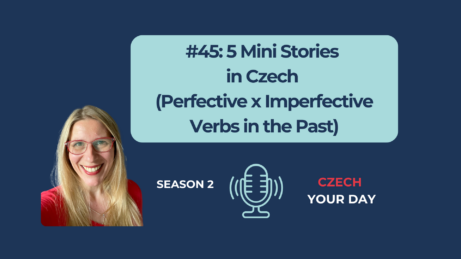Episode 3 (daily podcast CZECH YOUR DAY) transcript included

THIS WEEK’S TOPIC: SPRING CLOTHES (JARNÍ OBLEČENÍ) THE TRANSCRIPT/HANDOUT IS DOWN BELOW
In today’s exploration, we’ll be discussing several expressions used in Czech to describe the act of getting dressed. Understanding these verbs is key to sound more like a native.
Don’t miss any of the episodes this week to ensure you are able to understand Thursday’s or Friday’s episodes.
Verb 1: OBLÉKAT SE
The first verb is an expression used when talking about getting dressed without mentioning specific clothing items. When you want to state the simple fact of dressing up, you use „OBLÉKAT SE.“
- Example: JÁ SE OBLÉKÁM. (I am getting dressed.)
- In context: Teď se oblékám. Počkej chvilku. (I am just getting dressed. Wait a second.)
- Another scenario: Budu hotová za pět minut. Ještě se oblékám. (I will be ready in five minutes. I’m still getting dressed.)
Verb 2: OBLÉKAT SI
When you’re mentioning the specific clothing items you’re putting on, that’s when „OBLÉKAT SI“ comes into play. The key difference here is the reflexive nature of the verb.
- Examples:
- Oblékám si bundu. (I am putting on a jacket.)
- Oblékám si kalhoty. (I am putting on trousers.)
- Oblékám si halenku. (I am putting on a blouse.)
- Oblékám si tričko. (I am putting on a T-shirt.)
Verb 3: OBLÉKAT
This verb is used when someone else is dressing you, such as a mother dressing her baby: „MAMINKA OBLÉKÁ MIMINKO,“ meaning the mom is getting the baby dressed.
Understanding MÍT NA SOBĚ and NOSIT
Two other verbs frequently used are „MÍT NA SOBĚ“ and „NOSIT.“
- MÍT NA SOBĚ: Literally translates to „have on yourself,“ similar to „I am wearing“ in English.
- Example: Co máš teď na sobě? (What are you wearing right now?)
- NOSIT: Meaning „to wear,“ often used in asking about preferences.
- Examples:
- Nosíš ráda čepici? (Do you like wearing a cap?)
- Nosíte brýle? (Do you wear glasses?)
- Examples:








